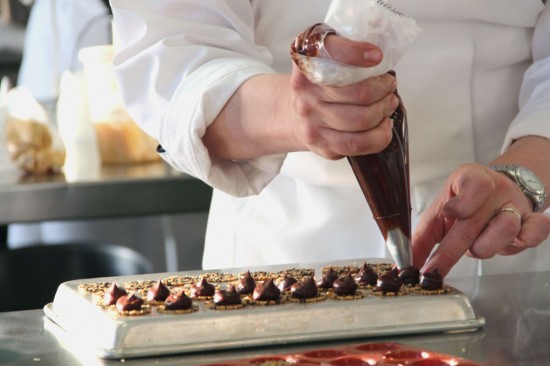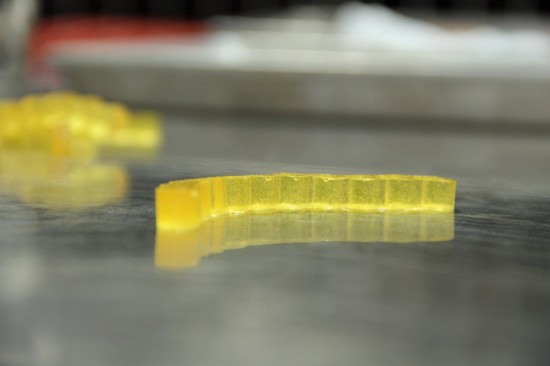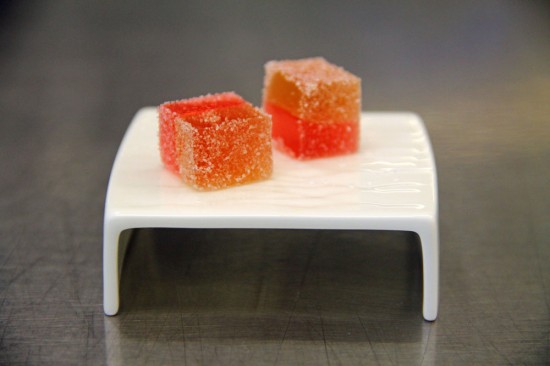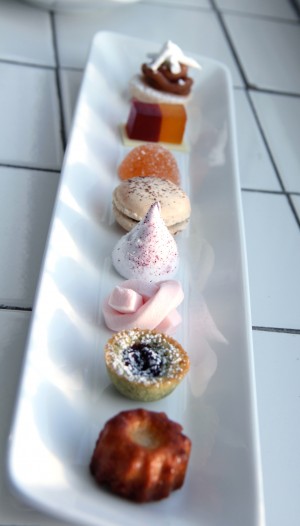As a professional pastry chef, I have a deep relationship with candy. But then don’t we all? Several years ago, I began to ponder the ‘culture’ that surrounds our taste for sweets. What I came to realize is that we relate to sweetness on three different levels: the physiological, the psychological, and the nostalgic.
With the possible exception of salt, the instinctual desire for sweetness—more than any other taste—is surely hardwired somewhere deep within our DNA. From the moment of birth, we seek our nourishment and comfort in the rich, sweetened form of mother’s milk; it is indeed the only taste we know in our early months. Eventually our sense of taste becomes considerably more complex as our food choices expand, but I find it interesting that, for all humans, the craving for sweet endures. Just when we might otherwise mature beyond that physiological need, the desire manifests itself in the realm of emotion.
As with Proust’s famous madeleine, it is often sweets that become intertwined with memory, emotion and a sense of comfort. Dessert functions as a reward for "eating those vegetables," a miracle salve for that scraped knee, or even a mischievous child’s stolen secret. The acquisition of penny candy is often a child’s first foray into the world of commerce and finance. With sweetness we begin to associate comfort, pleasure, reward, envy, and guilt.

Personal nostalgia will vary by culture, country, region, or generation; our source material might be a freshly baked pie like Grandma used to make, or it may come in the form of mass produced junk food (I’m convinced that all pastry chefs have, consciously or not, tried to recreate a Snickers bar in some way or another). These associations remain through adulthood. Playing to this inner child, for a pastry chef, can initiate the creation of something new yet familiar. The context of such nostalgia—especially unexpected in a fine dining environment—heightens such playfulness.
The more I explore this notion, the more fascinating I find it and the more I enjoy tapping into those emotions. In other words, the true path to our inner selves may indeed be something as simple as candy. Though confections are tucked beneath the broad umbrella of pastry arts that includes chocolate, ice cream, cakes, and plated desserts, my own interest in candy has increased along with a better understanding of its underlying science. Through candy-making we can explore the properties of sugars and fats, the behavior of concentrated syrups and crystallization, and numerous complex interactions that influence taste and texture.

A historical survey of the candy trade reveals that, though there has been much innovation, the sweets crafted in the Middle Ages or in ancient Rome may not have seemed all that unfamiliar to us today. Once the cost of ingredients like sugar and chocolate decreased more than a century ago (in conjunction with technical leaps and bounds made during the Industrial Revolution), candy truly became accessible to all. Most of the brands we recognize today had their roots in this "candy renaissance." Though the world of confections includes many different styles, from hard candy to soft caramels and dense nougats to fluffy marshmallows, here are some simple guidelines that I believe will help all cooks—the amateur and pro alike—achieve sweet success:
Brush up on your basics.
Most candies tend to conform to tried and true formulas, but that shouldn't prevent us from creating unique versions of the classics. With just a little bit of research, we can easily begin to grasp the physics and chemistry at play, which eventually allows us to experiment with whimsy.

Controlling crystallization, for example, is very important. Understanding just when to stir a sugar syrup (or when not to) and when to use inhibitors like acids and glucose will help provide the right end result. Simple knowledge of basic hydrocolloids can help us craft a range of textures like chewy gummies, melt-in-your-mouth pâtes de fruits and ultra-light marshmallows.
Navigating the complex flavor-creating mechanisms of caramelization and Maillard reactions help us understand what is happening as our cooked confections transform into something greater than the sum of their parts. My own recent explorations have resulted in tooth-friendly sugar-free candies for a private client and "savory" confections flavored with vegetable juices, such as carrot. With just a little confidence, patience, and know-how, the sky is the limit!
Sweat the small stuff.
Even slight changes in formula can lead to both discovery and disaster. Until one is comfortable with making informed adjustments and substitutions, it’s best to pay close attention to recipes. Accuracy in measuring ingredients and temperature are vital, and to this end I recommend starting with a calibrated digital thermometer and a good digital scale. Virtually all candies require cooking to exact temperatures, and measuring by weight (preferably metric) versus volume will always offer more precision. Beyond simple tools such as a heat-proof rubber spatula and a couple of small Silpats, an advanced candy amateur might also make good use of a mini marble slab, caramel rulers and flexible silicon molds.

Cleanliness is king. Organizing your tools, ingredients and workspace is the first step toward successful candy work. Not only will dirty utensils lead to problems like crystallization, but overall clutter in the kitchen can also lead to accidents (molten sugar syrups that reach temperatures as high as 325˚F can result in serious burns). Stay clean, don’t get distracted and avoid walking away from a potentially dangerous pot of boiling sugar! Below, you'll find one of my favorite soft caramel recipes, and for those interested in digging a bit deeper into candy science, I’ll be teaching a new class on the subject - Sugar Science: Functions and Applications in Modern Pastry on Wednesday, July 16. I hope to see you there!
Soft Caramel
Yield: one 12cm by 12cm block, or about 50 individual candies
Ingredients
- 125g glucose syrup
- 15g invert sugar
- 3g fine sea salt
- 1 vanilla bean, split and scraped
- 210g heavy cream (35% fat)
- 115g sucrose
- 30g water
- 10g cocoa butter (optional)
Instructions
- In a heavy saucepan, combine the cream, glucose, invert sugar, salt and vanilla. Gently heat and reserve.
- In a second saucepan, combine the sucrose and water. Cook to a medium dark caramel. Deglaze with the warm cream mixture and continue to cook to 118°C/245°F. Remove from heat and stir in the cocoa butter.
- Immediately pour the caramel into a set of bars lined with a Silpat. Cool several hours before cutting and wrapping in cellophane or waxed paper.




